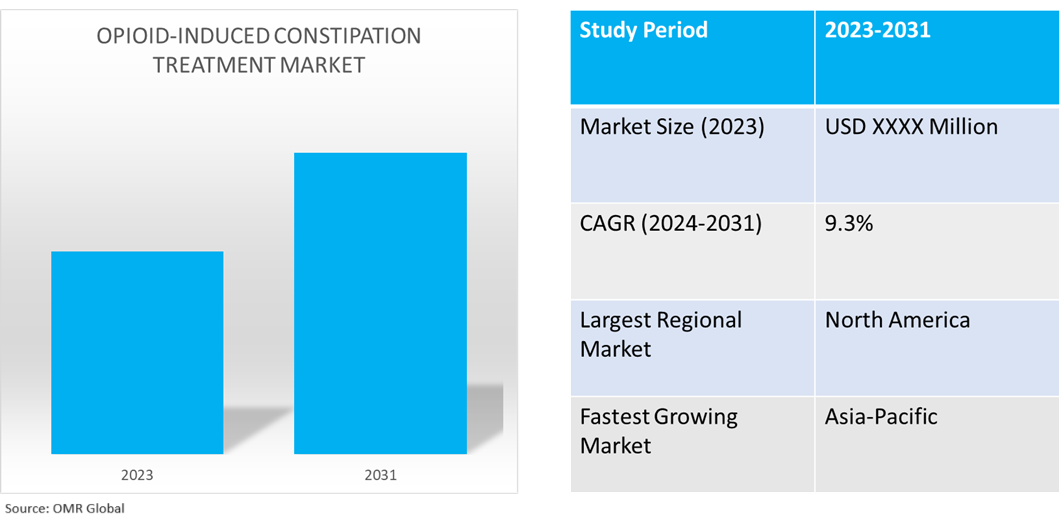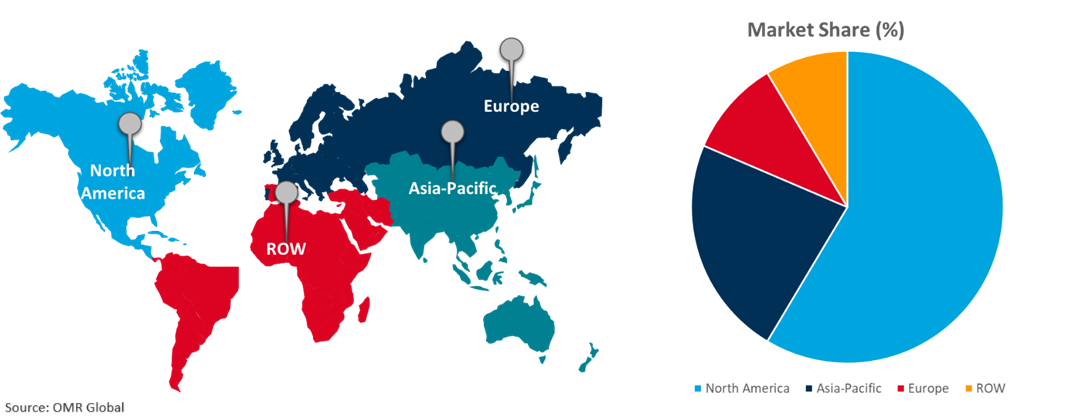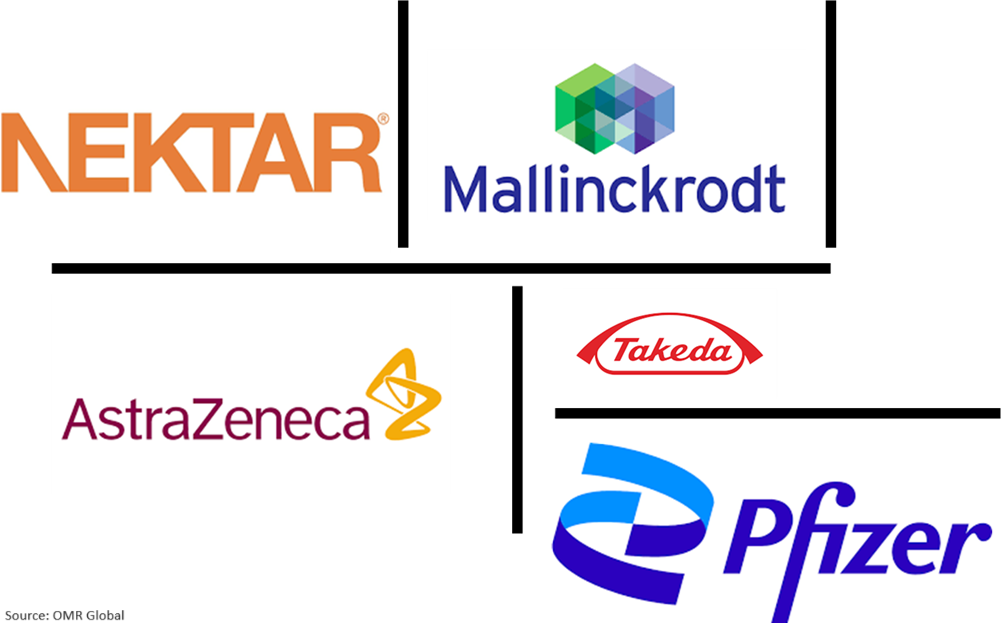Opioid-Induced Constipation Treatment Market
Opioid-Induced Constipation Treatment Market Size, Share & Trends Analysis Report by Drug Class (Laxatives, Peripherally Acting Mu-opioid Receptor Antagonists, Serotonin Receptor Agonists, and Prostaglandin), by Administration Route (Oral and Parenteral), and by Distribution Channel (Hospital Pharmacies, Online Pharmacies and Retail Pharmacies) Forecast Period (2024-2031)
Opioid-Induced Constipation (OIC) treatment market is anticipated to grow at a significant CAGR of 9.3% during the forecast period (2024-2031). The market growth is attributed to pivotal factors such as enhancing financing for R&D allows for the investigation of targeted treatments intended to tackle the difficulties associated with opioid-induced constipation. Precision medicine and medicines that specifically address the underlying causes of constipation are gaining ground and improving treatment success. According to the National Center for Biotechnology Information (NCBI), in April 2024, globally, in international studies, the prevalence of OIC ranges from 8.9% to 81.0%. The prevalence of OIC increases with the prolonged duration of opioid use. In an American cohort, the prevalence was 6.0% over more than 80,000 patients, however, it was shown that constipation symptoms were more severe than in chronic idiopathic constipation.

Market Dynamics
Increased Demand for Prescription Medications
Methylnaltrexone, naldemedine, and naloxegol are among the medications that are administered more frequently. These drugs selectively target opioid receptors in the gastrointestinal system, without compromising pain alleviation. It is more usual to combine laxatives with other drugs, such as peripherally acting Mu-opioid receptor antagonists (PAMORAs), to increase their efficiency. First-line treatment is advised to include stimulant laxatives and osmotic (polyethylene glycol, ideally). In individuals who have not responded to first-line therapies, peripherally acting ?-opioid receptor antagonists such as methylnaltrexone, naloxegol, or naldemedine should be administered.
Development of New Therapies
Novel medications with distinct mechanisms are being researched. For instance, guanylate cyclase-C agonists such as plecanatide and linaclotide, which enhance intestinal fluid secretion and facilitate better bowel movements, and chloride channel activators like lubiprostone. When a patient takes an opioid, OIC may appear right once, or it may appear gradually for opioid medication. Patients may also experience bloating, nausea, vomiting, stomach pain, and straining in addition to constipation. Many individuals who experience constipation after using opioids discontinue their medication as they are unable to handle the negative effects on their gastrointestinal system. When opioid-induced constipation sets in, therapy takes time to take effect and doesn't always provide the best constipation relief.
Market Segmentation
- Based on the drug class, the market is segmented into laxatives, peripherally acting mu-opioid receptor antagonists, serotonin receptor agonists, and prostaglandin.
- Based on the administration route, the market is segmented into oral and parenteral.
- Based on the distribution channel, the market is segmented into hospital pharmacies, online pharmacies, and retail pharmacies.
The Oral Administration Route is Projected to Hold the Largest Market Share
The primary factor supporting the growth is, it is an easy and non-invasive treatment. These oral medications support the expansion of OIC treatment, through improved patient compliance. As oral administration is more convenient, patients are more likely to stick to their prescribed regimens. Better control of constipation as a result of increased compliance enhances patient outcomes and strengthens the place of oral medications in the broader therapeutic paradigm. Market players offering new treatment options for adult patients with chronic non-cancer pain suffering from opioid-induced constipation, a common side effect of opioid therapy. For instance, AstraZeneca offers US (FDA) approved MOVANTIK™ (naloxegol) tablets C-II as the first once-daily oral peripherally acting mu-opioid receptor antagonist (PAMORA) medication for the treatment of opioid-induced constipation (OIC), in adult patients with chronic, non-cancer pain.
Hospital Pharmacies to Hold a Considerable Market Share
As hospital pharmacies are hubs where patients can get their prescribed drugs and medical attention, the segment is anticipated to have the highest growth rate. They have easy access to individuals who might need to be treated for constipation brought on by opioids. Hospital pharmacies are the main suppliers of opioid-induced constipation, attributed to their easier access to patients. Additionally, hospital pharmacists are outfitted with the tools necessary to preserve opioid-induced constipation in the right circumstances, preserving its stability and integrity. They follow stringent norms and regulations regarding their handling and storage, to ensure the safety and effectiveness of pharmaceuticals.
Regional Outlook
The global opioid-induced constipation treatment market is further segmented based on geography including North America (the US, and Canada), Europe (the UK, Italy, Spain, Germany, France, and the Rest of Europe), Asia-Pacific (India, China, Japan, South Korea, and Rest of Asia-Pacific), and the Rest of the World (the Middle East & Africa, and Latin America).
Growing Demand for Opioid-Induced Constipation Treatments in Asia-Pacific
The regional growth is attributed to increasing demand for opioid administration for both cancer and non-cancer pain. The key companies in the region for treating opioid-induced constipation are innovating mu-opioid receptor antagonists to cater to the specific requirements of patients grappling with opioid-induced constipation (OIC). According to the National Center for Biotechnology Information (NCBI), the prevalence of self-defined constipation in Asian adults (from South Korea, China, and Indonesia) was estimated to be 15.0%–23.0% in women and approximately 11.0% in men.
Global Opioid-Induced Constipation Treatment Market Growth by Region 2024-2031

North America Holds Major Market Share
North America holds a significant share owing to the presence of opioid-induced constipation treatment offering companies such as Cayman Chemical Co., Nektar Therapeutics, Pfizer Inc., and others. The market growth is attributed to the increasing prevalence of constipation among cancer patients in the region. According to the Oncology Nursing Society, Constipation occurs in about 60.0% of patients with cancer and can be distressing to patients during treatment, survivorship, and palliative care. Gastrointestinal diseases are a serious medical problem for women, and some, such as irritable bowel syndrome (IBS), occur more frequently in women than men. According to the Johns Hopkins University, about 4 million people in the US have frequent constipation. Constipation is the most common gastrointestinal complaint, resulting in 2.5 million doctor visits annually. Market players offer palliative care for individuals with advanced illnesses who have constipation brought on by opioids. For instance, Pfizer Inc. offers RELISTOR® indicated for the treatment of opioid-induced constipation in patients with advanced illness who are receiving palliative care, when response to laxative therapy has not been sufficient.
Market Players Outlook

*Note: Major Players Sorted in No Particular Order.
The major companies serving the opioid-induced constipation treatment market include AstraZeneca, Mallinckrodt Pharmaceuticals, Nektar Therapeutics, Pfizer Inc., and Takeda Pharmaceutical Co. Ltd. among others. The market players are increasingly focusing on business expansion and product development by applying strategies such as collaborations, mergers and acquisitions to stay competitive in the market.
The Report Covers
- Market value data analysis of 2023 and forecast to 2031.
- Annualized market revenues ($ million) for each market segment.
- Country-wise analysis of major geographical regions.
- Key companies operating in the global opioid-induced constipation treatment market. Based on the availability of data, information related to new products, and relevant news is also available in the report.
- Analysis of business strategies by identifying the key market segments positioned for strong growth in the future.
- Analysis of market-entry and market expansion strategies.
- Competitive strategies by identifying ‘who-stands-where’ in the market.
1. Report Summary
• Current Industry Analysis and Growth Potential Outlook
1.1. Research Methods and Tools
1.2. Market Breakdown
1.2.1. By Segments
1.2.2. By Region
2. Market Overview and Insights
2.1. Scope of the Report
2.2. Analyst Insight & Current Market Trends
2.2.1. Key Market Trends
2.2.2. Recommendations
2.2.3. Conclusion
3. Competitive Landscape
3.1. Key Company Analysis
3.2. AstraZeneca plc
3.2.1. Overview
3.2.2. Financial Analysis
3.2.3. SWOT Analysis
3.2.4. Recent Developments
3.3. Mallinckrodt Pharmaceuticals
3.3.1. Overview
3.3.2. Financial Analysis
3.3.3. SWOT Analysis
3.3.4. Recent Developments
3.4. Pfizer, Inc.
3.4.1. Overview
3.4.2. Financial Analysis
3.4.3. SWOT Analysis
3.4.4. Recent Developments
3.5. Takeda Pharmaceutical Co. Ltd.
3.5.1. Overview
3.5.2. Financial Analysis
3.5.3. SWOT Analysis
3.5.4. Recent Developments
3.6. Key Strategy Analysis
4. Market Segmentation
4.1. Global Opioid-Induced Constipation Treatment Market by Drug Class
4.1.1. Laxatives
4.1.2. Peripherally Acting Mu-opioid Receptor Antagonists
4.1.3. Serotonin Receptor Agonists
4.1.4. Prostaglandin
4.2. Global Opioid-Induced Constipation Treatment Market by Administration Route
4.2.1. Oral
4.2.2. Parenteral
4.3. Global Opioid-Induced Constipation Treatment Market by Distribution Channel
4.3.1. Hospital Pharmacies
4.3.2. Online Pharmacies
4.3.3. Retail Pharmacies
5. Regional Analysis
5.1. North America
5.1.1. United States
5.1.2. Canada
5.2. Europe
5.2.1. UK
5.2.2. Germany
5.2.3. Italy
5.2.4. Spain
5.2.5. France
5.2.6. Rest of Europe
5.3. Asia-Pacific
5.3.1. China
5.3.2. India
5.3.3. Japan
5.3.4. South Korea
5.3.5. Rest of Asia-Pacific
5.4. Rest of the World
5.4.1. Latin America
5.4.2. Middle East and Africa
6. Company Profiles
6.1. Alkermes, Inc.
6.2. Bausch Health Companies Inc. (Salix Pharmaceuticals)
6.3. Bayer AG
6.4. Cayman Chemical Co.
6.5. Collegium Pharmaceutical, Inc.
6.6. DAIICHI SANKYO CO. Ltd.
6.7. Dr. Reddy’s Laboratories Ltd.
6.8. Ironwood Pharmaceuticals, Inc.
6.9. Lepu Medical Technology (Beijing) Co., Ltd.
6.10. MedKoo Biosciences, Inc.
6.11. Nektar Therapeutics
6.12. Novartis AG
6.13. Sanofi S.A.
6.14. Shionogi & Co., Ltd.
6.15. Teva Pharmaceuticals
6.16. Theravance Biopharma
6.17. Valinor Pharma, LLC
1. Global Opioid-Induced Constipation Treatment Market Research And Analysis By Drug Class, 2023-2031 ($ Million)
2. Global Laxatives Opioid-Induced Constipation Treatment Market Research And Analysis By Region, 2023-2031 ($ Million)
3. Global Peripherally Acting Mu-opioid Receptor Antagonists Opioid-Induced Constipation Treatment Market Research And Analysis By Region, 2023-2031 ($ Million)
4. Global Serotonin Receptor Agonists Opioid-Induced Constipation Treatment Market Research And Analysis By Region, 2023-2031 ($ Million)
5. Global Prostaglandin Opioid-Induced Constipation Treatment Market Research And Analysis By Region, 2023-2031 ($ Million)
6. Global Opioid-Induced Constipation Treatment Market Research And Analysis By Administration Route, 2023-2031 ($ Million)
7. Global Oral Opioid-Induced Constipation Treatment Market Research And Analysis By Region, 2023-2031 ($ Million)
8. Global Parenteral Opioid-Induced Constipation Treatment Market Research And Analysis By Region, 2023-2031 ($ Million)
9. Global Opioid-Induced Constipation Treatment Market Research And Analysis By Distribution Channel, 2023-2031 ($ Million)
10. Global Opioid-Induced Constipation Treatment For Hospital Pharmacies Market Research And Analysis By Region, 2023-2031 ($ Million)
11. Global Opioid-Induced Constipation Treatment For Online Pharmacies Market Research And Analysis By Region, 2023-2031 ($ Million)
12. Global Opioid-Induced Constipation Treatment For Retail Pharmacies Market Research And Analysis By Region, 2023-2031 ($ Million)
13. Global Opioid-Induced Constipation Treatment Market Research And Analysis By Region, 2023-2031 ($ Million)
14. North American Opioid-Induced Constipation Treatment Market Research And Analysis By Country, 2023-2031 ($ Million)
15. North American Opioid-Induced Constipation Treatment Market Research And Analysis By Drug Class, 2023-2031 ($ Million)
16. North American Opioid-Induced Constipation Treatment Market Research And Analysis By Administration Route, 2023-2031 ($ Million)
17. North American Opioid-Induced Constipation Treatment Market Research And Analysis By Distribution Channel, 2023-2031 ($ Million)
18. European Opioid-Induced Constipation Treatment Market Research And Analysis By Country, 2023-2031 ($ Million)
19. European Opioid-Induced Constipation Treatment Market Research And Analysis By Drug Class, 2023-2031 ($ Million)
20. European Opioid-Induced Constipation Treatment Market Research And Analysis By Administration Route, 2023-2031 ($ Million)
21. European Opioid-Induced Constipation Treatment Market Research And Analysis By Distribution Channel, 2023-2031 ($ Million)
22. Asia-Pacific Opioid-Induced Constipation Treatment Market Research And Analysis By Country, 2023-2031 ($ Million)
23. Asia-Pacific Opioid-Induced Constipation Treatment Market Research And Analysis By Drug Class, 2023-2031 ($ Million)
24. Asia-Pacific Opioid-Induced Constipation Treatment Market Research And Analysis By Administration Route, 2023-2031 ($ Million)
25. Asia-Pacific Opioid-Induced Constipation Treatment Market Research And Analysis By Distribution Channel, 2023-2031 ($ Million)
26. Rest Of The World Opioid-Induced Constipation Treatment Market Research And Analysis By Country, 2023-2031 ($ Million)
27. Rest Of The World Opioid-Induced Constipation Treatment Market Research And Analysis By Drug Class, 2023-2031 ($ Million)
28. Rest Of The World Opioid-Induced Constipation Treatment Market Research And Analysis By Administration Route, 2023-2031 ($ Million)
29. Rest Of The World Opioid-Induced Constipation Treatment Market Research And Analysis By Distribution Channel, 2023-2031 ($ Million)
1. Global Opioid-Induced Constipation Treatment Market Research And Analysis By Drug Class, 2023 Vs 2031 (%)
2. Global Laxatives Opioid-Induced Constipation Treatment Market Share By Region, 2023 Vs 2031 (%)
3. Global Peripherally Acting Mu-opioid Receptor Antagonists Opioid-Induced Constipation Treatment Market Share By Region, 2023 Vs 2031 (%)
4. Global Serotonin Receptor Agonists Opioid-Induced Constipation Treatment Market Share By Region, 2023 Vs 2031 (%)
5. Global Prostaglandin Opioid-Induced Constipation Treatment Market Share By Region, 2023 Vs 2031 (%)
6. Global Opioid-Induced Constipation Treatment Market Research And Analysis By Administration Route, 2023 Vs 2031 (%)
7. Global Oral Opioid-Induced Constipation Treatment Market Share By Region, 2023 Vs 2031 (%)
8. Global Parenteral Opioid-Induced Constipation Treatment Market Share By Region, 2023 Vs 2031 (%)
9. Global Opioid-Induced Constipation Treatment Market Research And Analysis By Distribution Channel, 2023 Vs 2031 (%)
10. Global Opioid-Induced Constipation Treatment For Hospital Pharmacies Market Share By Region, 2023 Vs 2031 (%)
11. Global Opioid-Induced Constipation Treatment For Online Pharmacies Market Share By Region, 2023 Vs 2031 (%)
12. Global Opioid-Induced Constipation Treatment For Retail Pharmacies Market Share By Region, 2023 Vs 2031 (%)
13. Global Opioid-Induced Constipation Treatment Market Share By Region, 2023 Vs 2031 (%)
14. US Opioid-Induced Constipation Treatment Market Size, 2023-2031 ($ Million)
15. Canada Opioid-Induced Constipation Treatment Market Size, 2023-2031 ($ Million)
16. UK Opioid-Induced Constipation Treatment Market Size, 2023-2031 ($ Million)
17. France Opioid-Induced Constipation Treatment Market Size, 2023-2031 ($ Million)
18. Germany Opioid-Induced Constipation Treatment Market Size, 2023-2031 ($ Million)
19. Italy Opioid-Induced Constipation Treatment Market Size, 2023-2031 ($ Million)
20. Spain Opioid-Induced Constipation Treatment Market Size, 2023-2031 ($ Million)
21. Rest Of Europe Opioid-Induced Constipation Treatment Market Size, 2023-2031 ($ Million)
22. India Opioid-Induced Constipation Treatment Market Size, 2023-2031 ($ Million)
23. China Opioid-Induced Constipation Treatment Market Size, 2023-2031 ($ Million)
24. Japan Opioid-Induced Constipation Treatment Market Size, 2023-2031 ($ Million)
25. South Korea Opioid-Induced Constipation Treatment Market Size, 2023-2031 ($ Million)
26. Rest Of Asia-Pacific Opioid-Induced Constipation Treatment Market Size, 2023-2031 ($ Million)
27. Latin America Opioid-Induced Constipation Treatment Market Size, 2023-2031 ($ Million)
28. Middle East And Africa Opioid-Induced Constipation Treatment Market Size, 2023-2031 ($ Million)


